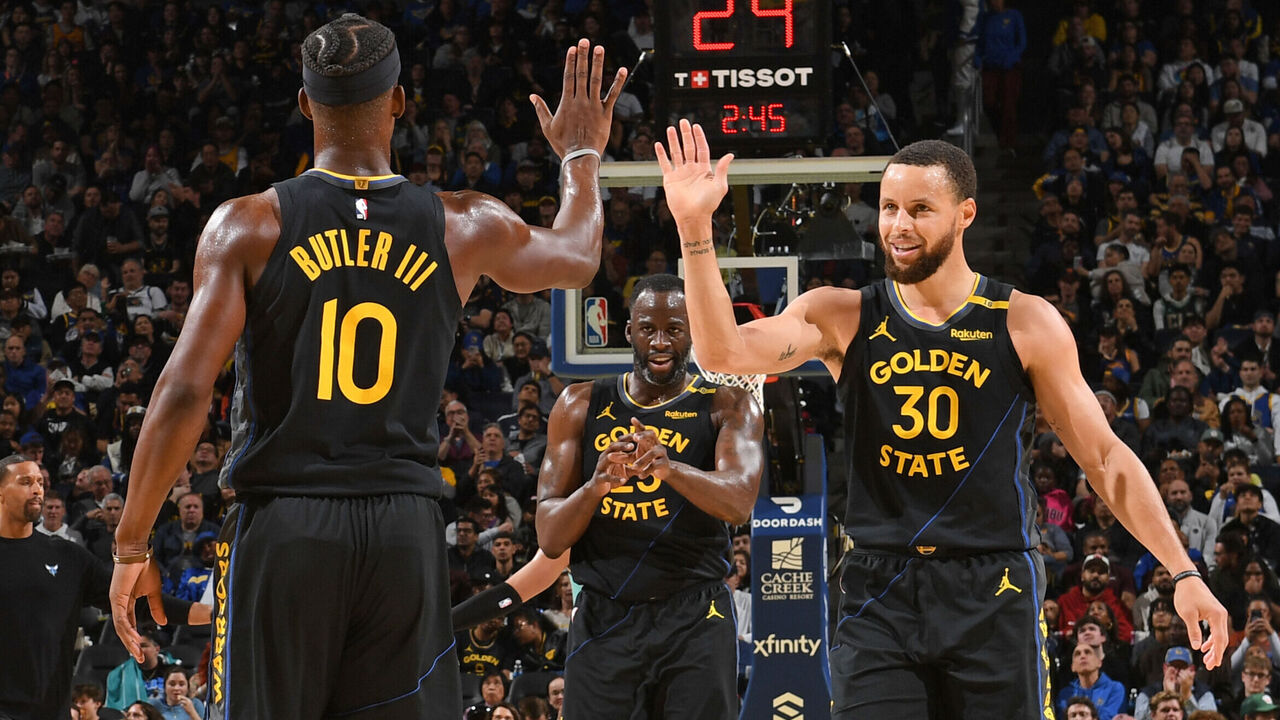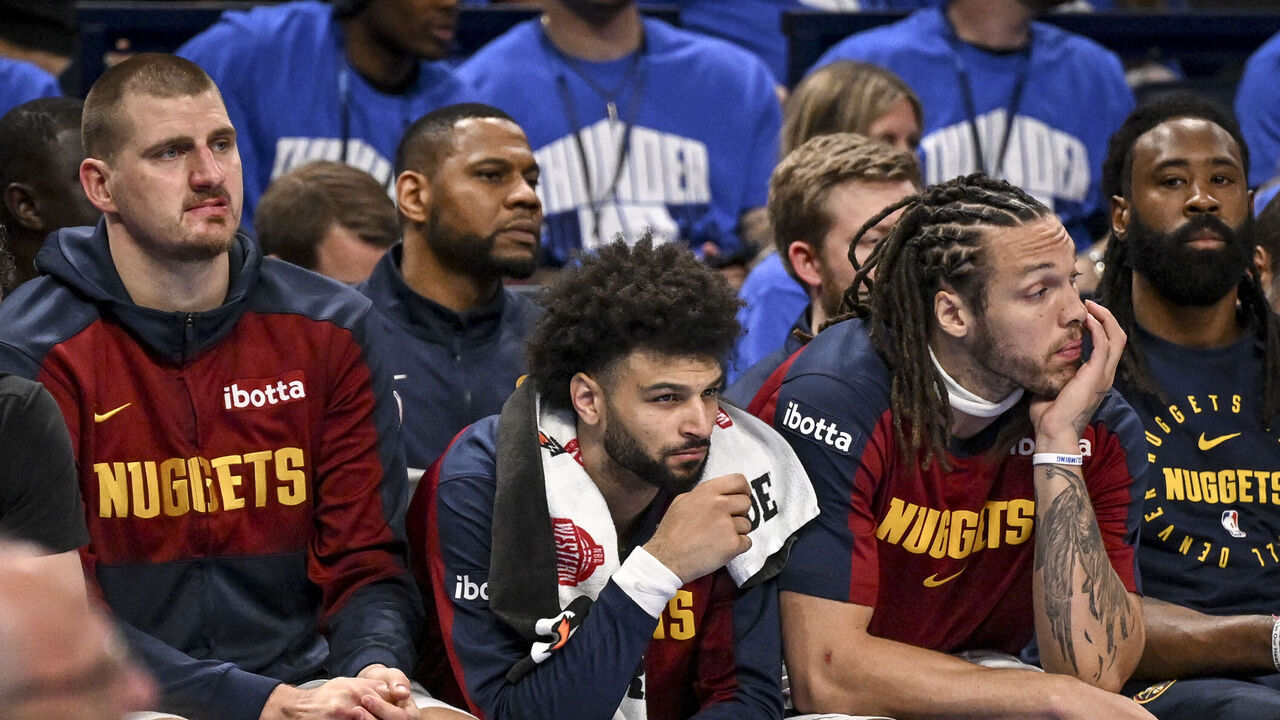What's next: Where the Warriors and Nuggets go from here
Every year, 29 teams fall short of the ultimate goal, and every year, those 29 teams ask themselves how they can take the next step.
We previously looked at how the first-round outs in the East and West might go about answering that question and examined the decisions on the horizon for the East's top two seeds after their seasons ended in the second round. Now that the West semis are complete, here's a look at how two of the conference's last three champions can move forward after being eliminated.
Golden State Warriors

The Warriors were bitterly disappointed by their five-game elimination at the Minnesota Timberwolves' hands, but few teams have as clear a vision as Golden State does right now. The mandate: Win another championship during the two-year window in which Steph Curry, Jimmy Butler, and Draymond Green are all under contract for a combined average of $143.4 million per season.
The three future Hall of Famers are all 35-37 years old with justifiable questions about their durability. Curry's absence did the team in against the Timberwolves, Butler hasn't suited up for 65 games in a season since 2018-19, and Green has reached the 70-game mark once in the last seven years. Still, even with those age-related concerns and Butler's diminishing offensive game, I'd take a healthy Steph, Jimmy, and Draymond against most teams' top three. Golden State went 23-7 (a 62-win pace) with Curry and Butler in the lineup down the stretch.
If the Warriors can just get those legends to the spring in one piece, they'll have a legitimate chance to raise another banner before Curry retires. Accomplishing that starts with shoring up the rest of the rotation, preferably by adding some size and athleticism.
The biggest question is what to do with restricted free agent Jonathan Kuminga, who has a big fan in team owner Joe Lacob but has often fallen out of favor with head coach Steve Kerr (though Kuminga did play well when he returned to the rotation during the second round). If he's retained at a reasonable price and can find some consistency, Kuminga can energize the aging core. But the best result for both parties seems to be Kuminga landing elsewhere in a sign-and-trade that delivers something of value for the Warriors too.
Golden State just doesn't have enough dependable rotation pieces, let alone game-changers. Brandin Podziemski and Buddy Hield provide spacing; the former is younger, more defensively capable, and a better playmaker, but not necessarily more consistent. Moses Moody is probably the most underrated youngster on the roster, which leaves me wondering if the Warriors would be better served putting Podziemski on the trade market and Moody on the court.
Trayce Jackson-Davis is a decent depth piece further down the bench and Gui Santos and Quinten Post were nice finds, but none of those three will alter Golden State's trajectory.
If the Warriors can find a way to turn some of that middling talent into even a couple more playoff-proof rotation players, they'll be in good shape. They also have up to four first-round draft picks (plus swaps) to package with those players if they want to make a bigger splash. That seems unlikely, but never count the Warriors out of such discussions - they've got about $17.4 million worth of wiggle room under the luxury-tax threshold and roughly $25 million worth of space under the first apron. - Joseph Casciaro
Denver Nuggets

This is a hugely consequential offseason in Denver with a ton of important decisions to make at every level of the organization. First: Finding the person who will make the rest of the decisions. Whoever steps into Calvin Booth's vacant role as general manager will quickly have to figure out how to make the necessary personnel adjustments while also deciding whether to conduct an external coaching search or make David Adelman's interim position permanent. (Adelman's performance after taking over with a week remaining in the regular season was a pretty persuasive job application.)
In overcoming a very good LA Clippers team and then pushing the 68-win Oklahoma City Thunder to the brink, the Nuggets proved they're still a threat to win any series with a Nikola Jokic-Jamal Murray-Aaron Gordon nucleus. Jokic is a one-man offense who somehow got even better this year. Murray shook off a tough start to have a strong second half and a sporadically brilliant postseason. Gordon patched every defensive hole, bludgeoned his way to copious offensive rebounds and paint buckets, and hit some of the clutchest shots of the playoffs.
But it also became abundantly clear, if it wasn't already, that the Nuggets need to make changes around that core trio if their championship window is to remain open while the 30-year-old Jokic is still in his prime.
Outside of Gordon and Christian Braun, the roster distinctly lacks two-way players. This year's Nuggets had the best offense of the Jokic era teams despite ranking last in 3-point attempt rate, but that limiting factor became harder to overcome against playoff defenses that ignored about half the members of their eight-man rotation. Their bench was once again a complete disaster, with no reliable backup center or 3-and-D wing. That eight-man rotation was basically a 5.5-man rotation by postseason's end.
What's less clear is how feasible the necessary changes are. If Russell Westbrook and Dario Saric pick up their player options (the former would likely be fine with Denver, the latter will be as damaging as it is inevitable), the Nuggets will be about $15 million over the tax line, $7 million over the first apron, and $5 million below the second apron with 13 of 15 roster spots filled. As things stand, they won't have access to the mid-level or bi-annual exception, nor will they be able to take back more salary than they send out in a trade. Plus, the only first-rounder they can currently include in a deal is their 2031 pick.
Whether Michael Porter Jr. remains part of the aforementioned core might be the most pressing roster question. Porter's been a key piece of the Nuggets for the last six years. He played a vital role in the team's championship two years ago and brings the specific skill (shooting) that's in shortest supply in Denver. But his precarious health, shaky defense, and near-$40-million-a-year salary make him the most natural starter to trade. The problem is that those same factors would also depress his market. He might still be more valuable to the Nuggets than he is to anyone else.
Braun made a strong case in his third season (and especially these playoffs) to be part of the team's long-term plans. He's extension-eligible this summer, and the Nuggets will surely try hard to come to an agreement with him. You can say everyone else should be on the table, but guys like Peyton Watson and Julian Strawther are about as likely to develop into the players Denver needs as they are to bring back those players in trades. The Nuggets would probably have to attach an asset to get off Zeke Nnaji's deal, which is worth doing if they can get any kind of competent rotation player in return (and possibly even if they can't). Maybe DaRon Holmes II can finally provide some stability at the backup five spot.
For the Nuggets' next GM, the opportunity to retool around Jokic is both a blessing and a curse. On one hand, you can explore some unconventional possibilities knowing Jokic will find a way to elevate everyone around him and keep the team competitive. On the other hand, you'll be under immense pressure to meaningfully improve the roster while Jokic is still playing at this level, but you'll have limited pathways to do so.
Nothing less than the legacy of one of the greatest players of this or any generation may depend on how that incoming GM navigates these next few months. - Joe Wolfond